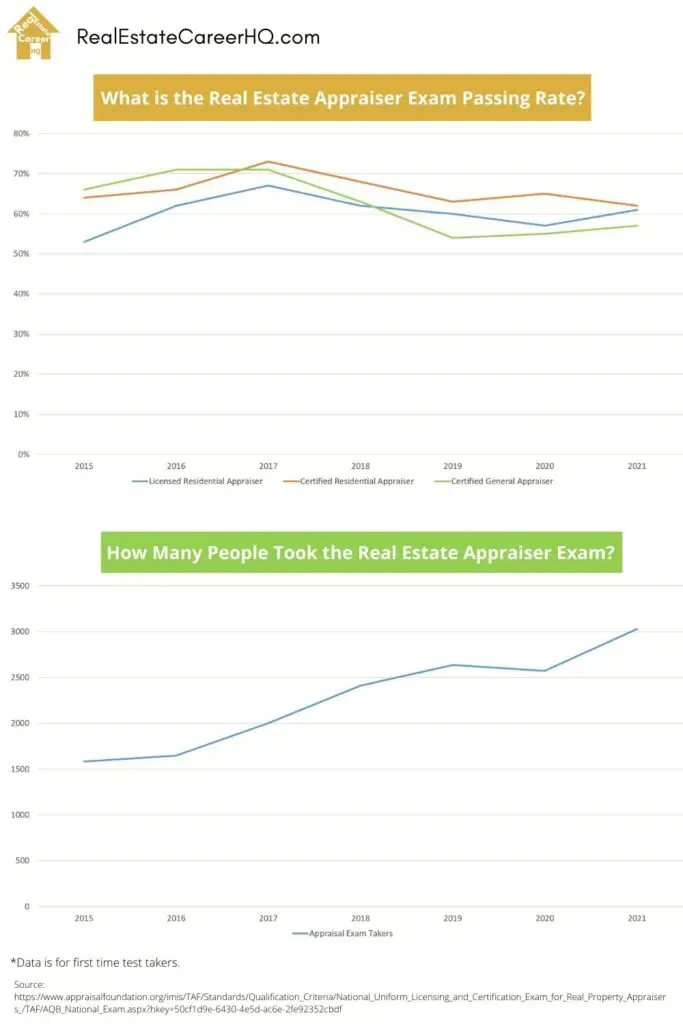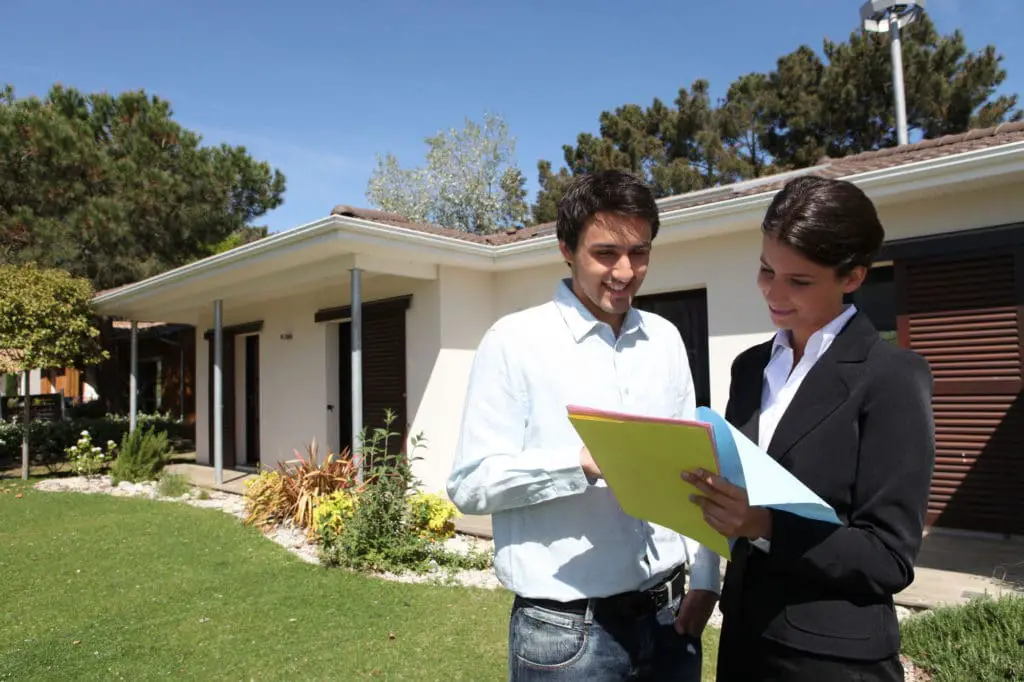(**) Disclosure: This post may contain affiliate links, meaning RealEstateCareerHQ.com will get a commission if you decide to make a purchase through the links, but at no additional cost to you.
To become a real estate appraiser, in addition to completing the qualifying education and work experience, you would also need to pass the National Uniform Licensing and Certification Examinations. This is the required exam for being a Licensed Residential Appraiser, Certified Residential Appraiser, and Certified General Appraiser.
So how to pass the real estate appraisal exam? To pass the real estate appraisal exam, an exam taker must obtain a passing score of 75 out of the 125 questions.
Passing the appraiser exam does take some effort and studying time. But just like anything, nothing worthwhile comes easy. The good news is there are different tools in helping you to prepare for the appraiser exam.
I notice that some of you may find it stressful and challenging to pass the test. Therefore, I did extensive research and gathered feedback from several appraisers who have gone through the exam process.
In this article, I’d love to share with you what I learned from them, helpful ideas to prepare for the exam, and the appraisal subjects that could be tested.
Table of Contents
- Statistics on the Real Estate Appraiser Exam
- 10 Practical Tips in Passing the Real Estate Appraiser Exam
- Tip #1: Take classes from a State Board approved course providers
- Tip #2: Read over the Appraiser Examination Candidate Handbook
- Tip #3: Read over the USPAP Manual
- Tip #4: Work on practice questions
- Tip#5: Spread out your study time
- Tip#6: Bring the questions to the Real -Life
- Tip#7: Bring the required identification documents
- Tip#8: Get a financial calculator
- Tip#9: Have a good meal
- Tip#10: Arrive early at the exam center
- Here’s more info about the National Uniform Licensing and Certification Examinations
- Video: Real Estate Appraiser Exam Sample Questions
- Conclusion
Statistics on the Real Estate Appraiser Exam

I got these stats from The Appraisal Foundation website. As you can see, there has been an increasing trend of people writing appraisal exams over the years. This is a good sign as more people are giving their vote of confidence in this profession.
The passing rate for the National Uniform Licensing and Certification Examination mostly ranged between 60% and 70%. Now, let’s go over some tips to increase your pass rate.
10 Practical Tips in Passing the Real Estate Appraiser Exam

Tip #1: Take classes from a State Board approved course providers
Before you write the exam, you’ll need to complete the qualifying education requirement.
I don’t like frequent traveling to a school, and I also have a relatively short attention span when sitting in a classroom. Therefore, when choosing a licensing course provider, it is important to find one that has the online lectures option. This way, you could get access to the course content whenever and wherever.
Although there are many appraisal education providers, their qualities are not the same. Choose one with extensive experience in teaching appraisal courses, and also has excellent review ratings from their students.
Here’s a review of the learning institution that I like for your reference.
Tip #2: Read over the Appraiser Examination Candidate Handbook
Depending on which state you are located, your exam could be administered by PSI, Pearson-Vue or others. Regardless of the exam administer, they should have an Appraiser Examination Candidate Handbook.
Here’s one from the Pearson-Vue for your reference. It clearly outlines all the procedures about the exam writing.
Tip #3: Read over the USPAP Manual
If you ask any existing real estate appraiser, they would tell you how important it is to understand the Appraisal Standard Practice in the current regulatory environment. Therefore, you can expect there would be questions about the USPAP in the exams. Most of them are just memorizing questions.
Tip #4: Work on practice questions

I believe this is one of the most important preparation in passing the exam. Of course, it would be nice if you could excel in EVERY topic in the course materials. But in reality, I haven’t come across any appraisers who can do that.
Therefore, I recommend you to first skim over the course materials. It’s okay that you don’t have an in-depth understanding at this stage. Then you could start working on a set of practice questions.
Review over the questions that you did wrong, and read over the specific topic from the course materials to gain a better understanding.
Then do another set of practice questions, and repeat the process until you can get over 85% on these practice tests. Note: Despite the passing mark is only 75, but you could get nervous during the exam. So I want you to feel more confident at the time you enter the exam room.
Sample Question
1. The subject property is a 10,000-sf office building encumbered by a full-service lease with a contract base rent of $1.25 per square foot monthly. Stabilized vacancy/credit loss allowance for similar properties within the market area is 7% of PGI. The operating expense ratio for similar properties is 30% of EGI, plus reserves for replacement of $0.15 per square foot. What is the projected net operating income?
A) $93,000
B) $94,500
C) $96,150
D) $97,650
Quote from Pearson Vue National Appraiser Examination Candidate Handbook Nov 2017
So where could you get the practice questions? There are a few sample questions you could read from the Pearson Vue Candidate Handbook. You can also find some sample questions later in this post. However, you’ll probably need to do a lot more practice questions than that. So the best is to check out from a trusted appraisal education provider.
McKissock has exam prep packages for those who wish to become a licensed and certified residential appraisers. It helps you to prepare for the exam through self-paced online prep and live crammer sessions. You will also able to identify your strengths and weaknesses, so you may focus on areas that needs improvement. Click here for McKissock Exam Prep (**)
Tip#5: Spread out your study time
A lot of people have the habit to procrastinate and try to cram all study materials in one to two days before the exam.
However, your studies could be more effective if you do so regularly, for periods of about 45 to 60 minutes. For any period longer than that, your concentration would start to wander.
Besides, the purpose of your study is not just to pass the exam. This appraisal knowledge will eventually be useful when you start working in the field.
Tip#6: Bring the questions to the Real -Life

Studying for the sack of passing an exam could feel dreadful. You need to understand why a specific question is being tested is because it could actually be applied to your appraisal career in the future.
Talk to your colleagues or Supervisor and find out how these questions could be applied in their daily work.
Tip#7: Bring the required identification documents
Most test centers would require you to bring two forms of government issued ID. (i.e., Driver license, state ID, passport). Make sure they are not expired.
In addition, some states could need you to bring the approval letter and the green card.
Tip#8: Get a financial calculator
You’ll definitely need a good one to handle all the tricky math questions. (i.e.: amortization, depreciation, adjustment).
Keep in mind the test center proctor needs to ensure all formulas are cleaned off before the exam. Therefore, some would require you to bring along the calculator’s instructional manual. If you don’t have one, then you should download one just in case they need it.
The following is recommended but not required:
• Financial calculator that does not contain alpha characters and is non-programmableCandidates are not permitted to use a calculator or other computing tool that is alpha programmable. Only calculators that are not alpha programmable such as the HP12C are permitted.
Quote from Appraiser Examination Candidate Handbook
Tip#9: Have a good meal
The exams are very long which range from 4 to 6 hours. However, you will not be allowed to drink or eat in the exam room. Therefore, make sure you don’t go empty stomach.
Some foods are in the brain-boosting category. They are usually protein-rich and could lead to greater mental alertness. On the exam day, you may consider food choices such as nuts, yogurt, and cottage cheese, whole-grain cereal with low-fat milk, eggs and toast with jam, porridge, oatmeal, or sugar-free muesli. Other dietary brain foods may include fish, walnuts, blueberries, sunflower seeds, flaxseed, dried fruits, figs, and prunes.
On the other hand, some foods may block your brain out. On exam day, avoid foods that are made of white flour (i.e., cookies, cakes, and muffins.) They may require added energy to digest. A large portion of carbs, such as rice or potatoes, can also make you feel heavy and sleepy.
Furthermore, stay away from foods and drinks that are high in refined sugar — for example, chocolates, desserts, candies, sugary sodas, and colas. They will make unstabilize your sugar level, which is the opposite of what you need during a long exam.
Some exam centers would allow one scheduled break. Although you might want to get some snacks or coffee during that time, the chances are there could be a huge lineup as every student would be heading to the same place. Therefore, it’s better to bring your own snacks and drinks.
Tip#10: Arrive early at the exam center

The tension of writing an exam is already great for many people. The last thing you want is to add-on unnecessary stress by rushing into the exam room. You should arrive at least 30 minutes early.
Do a Google Map Search the day before the exam and make sure you know where the test center is located. I like searching on Google Street View. It gives me a vivid idea of what the building and its surrounding looks like.
If you are taking public transportation, then find out exactly the type of vehicles you need to take. On the other hand, if you’ll be driving, then get to know its closest parking lots. But either way, you should account for the traveling time and give yourself a buffer room.
At the test center, many people would try to cram up more study materials into their head. However, I don’t like this practice because it could make you panic and end up more confused. Keep in mind that your objective in the test center is not to study but to demonstrate what you have prepared all along.
Here’s more info about the National Uniform Licensing and Certification Examinations

The purpose of these exams is to test out your knowledge and experience in the appraisal work. The topics being tested will be related to the “Required Core Curriculum” modules, which are qualifying education you should have completed before writing the exam.
To give you a better idea of the exams here’s the Examination Content Outline from the Appraisal Foundation:
| Licensed Residential Appraiser | Certified Residential Appraiser | Certified General Appraiser | |
|---|---|---|---|
| Real Estate Market | 18% | 18% | 18% |
| Property Description | 11% | 12% | 11% |
| Land or Site Valuation | 3% | 3% | 4% |
| Sales Comparison Approach | 22% | 18% | 13% |
| Cost Approach | 13% | 14% | 11% |
| Income Approach | 4% | 8% | 18% |
| Reconciliation of Value Indications | 2% | 2% | 2% |
| Uniform Standard of Professional Appraisal Practice (USPAP) | 20% | 18% | 17% |
| Emerging Appraisal Methods | 3% | 4% | 3% |
| Appraisal Statistical Methods | 4% | 3% | 3% |
Here’s the breakdown of the sub-topics:
Real Estate Market: Types of Influences on Real Estate Value; Types of Government Power; Types of Real Estate Value; Date of Value Premise; Market Analysis; Investment Analysis; Tests of Highest and Best Use; Analysis of Highest and Best Us
Property Description: Description of Land or Site; Description of Improvements and; Building Components; Legal Interest; Rights to Use; Property Taxation
Land or Site Valuation: Land or Site Valuation Methods
Sales Comparison Approach: Identification of Comparable Sales; Units of Comparison; Elements of Comparison; Quantitative Adjustments; Qualitative Adjustments; Reconciliation to Indicated Value by Sales Comparison Approach
Cost Approach: Sources of Cost Information; Cost Components; Depreciation; Methods of Estimating Depreciation; Reconciliation to Indicated Value by the Cost Approach
Income Approach: Sources of Cost Generation; Occupancy / Vacancy Analysis; Expense Analysis; Capitalization Analysis; Estimation of Value Using Income Approach; Reconciliation to Indicated Value by the Income Approach
Emerging Appraisal Methods: Application of Online Property Information Database and Technological Tools; Appropriate Use and Limitations of the Hybrid/Bifurcated Appraisal Method; Use and Limitations of Automated Valuation Models
Appraisal Statistical Methods: Statistical Measures of Central Tendency; Statistical Measures of Variation; Inferential Statistical Techniques Used in Appraising
What is the format of the Appraiser Exam?
In most states, either PSI or Pearson-Vue will administer these exams. You can take it on a computer at their examination center.
- Licensed Residential Appraiser Exam is a 4 hours exam,
- Certified Residential Appraiser Exam is a 4 hours exam;
- Certified General Appraiser Exam is a 6 hours exam
The licensed and certified exams consist of 125 questions. Only 110 questions will be scored, and the other 15 are pretest questions. The required passing score is 75. You will immediately know your score once you finish writing the test.
Video: Real Estate Appraiser Exam Sample Questions
Here are more sample questions from the Appraisal Foundation
The local zoning ordinance requires that any property with impervious coverage that discharges more than 100,000 gallons of water in a 4-inch rainstorm must have a retention pond to handle the water. The proposed subject property will have 260,000 s.f. of impervious surface. A cubic foot of water contains 7.48 gallons and retention ponds can hold no more than 500,000 gallons for safety reasons. There is no retention pond on the plan. How should the appraiser describe the building and its compliance or noncompliance?
A. The building will discharge 86,667 gallons in a 4-inch rainstorm and will need a retention pond
B. The building will discharge 21,645 gallons in a 4-inch rainstorm and will not need a retention pond
C. The building will discharge 648,580 gallons in a 4-inch rainstorm and therefore needs a retention pond
D. The building will discharge 1,944,800 gallons in a 4-inch rainstorm and will need a retention pond
A new building representing the highest and best use of its site can be constructed at a total cost, including entrepreneurial incentive, of $12,000,000. The building capitalization rate is 11% and the land capitalization rate is 7%. The property will generate a net operating income of $1,500,000. What is the indicated value of the site, rounded to the nearest $1,000?
A. $6,750,000
B. $1,636,000
C. $2,571,000
D. $4,667,000
The subject property is 80 years old, and has a remaining economic life of 45 years, an observed age of 15 years, and, a total life of 60 years, using the straight line or age-life method. What is the total amount of accrued depreciation?
A. 25%
B. 33%
C. 18%
D. 56%
A four-unit residential property recently sold for $320,000. At the time of the sale it was fully occupied with each tenant paying $900 per month rent. The average vacancy rate is 5%. What is the indicated monthly gross rent multiplier derived from this sale?
A. 84.7
B. 84.4
C. 93.6
D. 88.9
The subject property has a two-car garage. The cost to add a third bay at the time of construction was $5,000. The cost to install a third bay on an existing property is $8,000. The market will pay $10,000 more for a house with a three-car garage. What is the garage adjustment to the sale price of the comparable sale with a three-car garage?
A. -$5,000
B. -$10,000
C. +$5,000
D. -$3,000
The subject is a 20-year-old residence with a replacement cost of $500,000. The costs to replace short-lived items along with physical life expectancy are: HVAC – $10,000, 25 years; and, roof cover – $12,000, 25 years. The roof was replaced five years ago. The water heater is malfunctioning and will cost $1,000 to replace. What is the incurable physical deterioration due to the HVAC?
A. $7,200
B. $8,000
C. $4,800
D. $2,400
Conclusion
Passing the appraiser exam indeed take some effort. Not only you’ll need to plan for your study ahead of time, but you should also cope with the stress in writing it. But let’s think in the bright side, if anyone could become a real estate appraiser with very little effort, then the profession would no longer be valuable.
I hope you’ll have a prosperous future in the appraisal career. Good luck on your exam, remember to leave me a comment after you pass it!
If you find this article useful, please remember to share it!
(**) Affiliate Disclosure: Please note that some of the links above are affiliate links, and at no additional cost to you. Our company, JCHQ Publishing will earn a commission if you decide to make a purchase after clicking on the link. Please understand that we include them based on our experience or the research on these companies or products, and we recommend them because they are helpful and useful, not because of the small commissions we make if you decide to buy something through the links. Please do not spend any money on these products unless you feel you need them or that they will help you achieve your goals.
Disclaimer: The information in this post is for general information only, and not intend to provide any advice. They are subjected to change without any notice, and not guaranteed to be error-free. Some of the posts on this site may contain views and opinions from individual not related to JCHQ Publishing. They do not necessarily reflect our view or position.
Reference:


Nice write up Jacob, taking mine this week. Definitely not easy.
I’m glad you find this guide helpful, Michael. I wish you all the best in the real estate appraisal career!